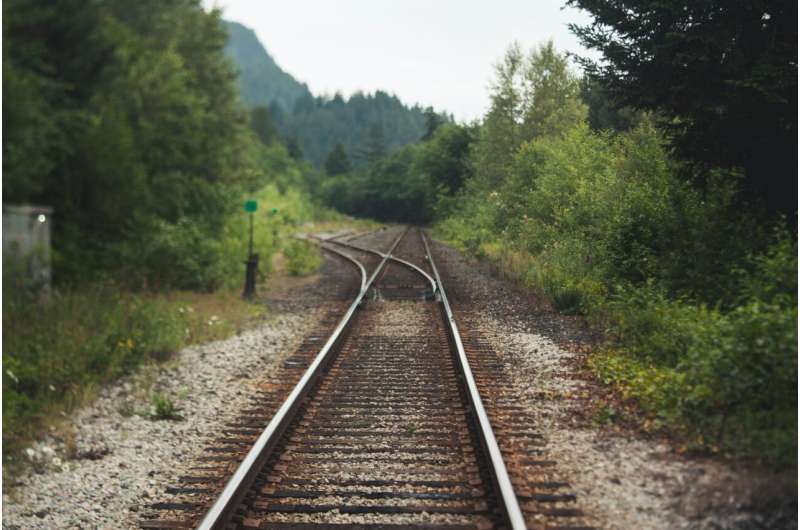
New lubricants, combined with new knowledge about how they should be applied to train wheels and rails, have the potential to reduce rail sector costs in Norway by hundreds of millions of kroner during the next decade.
The battle to mitigate climate change and the search for zero-emission technologies have promoted a desire in many countries to transfer more transport from the air and roads to the rail networks.
With this in mind, we at SINTEF and NTNU have had the opportunity to develop new knowledge on the interaction between lubricants, train wheels and the rails on which they run. Paradoxically, this field of research has been sadly neglected here in Norway.
Paradoxically? Because this very interaction has major implications for energy consumption, safety, maintenance costs, passenger comfort, noise levels, vibration and particle pollution within the rail network.
A uniform approach to a non-uniform problem
The lubricants used in the Norwegian rail sector, and the systems for their application, have hardly changed at all in recent decades.
It is also true to say that modern lubricants are more environmentally friendly than their predecessors.
However, we continue to use the same lubricants in all regions of the country, whether they are served by traditional trains, trams, metro systems or urban light railways. This in spite of the fact that the lifetimes of wheels and rails may be as much as 60% shorter in some parts of the country than in others because wear and tear varies from one line to another.
Three-fold improvement
All this creates the basis for our research project called WINTER, funded since 2021 by the Research Council of Norway, and which is now in the process of delivering the following three improvements to the rail sector:
- more environmentally-friendly lubricants. These are important because all lubricants used in the rail sector eventually end up in the external environment.
- lubricant application systems that are precisely adapted to the lubricant being applied and specifically tailored to the region in which they will be used.
- separate and customized application systems both for traditional rail networks and lighter, rail-based metro systems, urban light railways and trams.
Norway's most demanding line
On the basis of tests carried out on the Flåm line, which is the most demanding stretch in the Norwegian network, we estimate that the innovations developed in the WINTER project may result in annual savings in maintenance costs in excess of five million kroner on this line alone. In other words, more than 50 million kroner for every future decade.
Even though the line is only 20 kilometers long, the difference in elevation between the Flåm line's terminals at Myrdal and Flåm exacerbate the wear and tear on wheels and rails.
Our results and experience from the Flåm line thus cause us to anticipate savings of several hundred million kroner per decade across the entire Norwegian rail network.
Global implications
The WINTER project has its starting point in the needs of the Norwegian rail network. However, since wear and tear on wheels and rails represents a challenge to rail operators all over the world, our results also have global implications.
SINTEF and NTNU have been collaborating on research into green lubricants for more than ten years.
The project has involved collaboration with partners from the Norwegian rail sector such as Bane NOR, Flåm Utvikling, Vy, Sporveien, Boreal and Norske tog, as well as the lubricant system supplier Elba and the world's largest independent lubricant manufacturer Fuchs, which has been a pioneer in the development of green lubricants.
Together, we have addressed the issue from many aspects.
A thermal camera and microphones
Our investigations have been focused on the degradation mechanisms that impact on train wheels and rails exposed to wear and tear. Along the Flåm line we have used a thermal camera mounted on a train wheel axle, in combination with microphones, to obtain additional information on wear and tear mechanisms and the impact these have on noise and vibrations.
We have also carried out chemical analyses on the surfaces of both wheels and rails in an attempt to understand how different lubricant additives affect the performance of these components.
These analyses are used in turn not only to develop new lubricants, but also new methods of applying them. Issues that we have addressed include region-specific criteria for both the correct selection of lubricants and the amount of lubricant to be applied, the correct localization of application systems and appropriate application methods.
Benefits for many
Our research is being carried out in fields that are relatively unfamiliar to the general public.
However, the results of our work will benefit many. Society as a whole will be paying less for the maintenance of a key transport infrastructure. Train passengers, as well as households and businesses located close to rail lines, will experience less whistling and screeching from train wheels and rails. And last, but not least, the industrial companies involved in the project will obtain improved products that they can offer to the rail, metro and tram sectors.
Citation: New lubricants could offer cheaper and greener rail services (2024, January 11) retrieved 11 January 2024 from https://techxplore.com/news/2024-01-lubricants-cheaper-greener-rail.html
This document is subject to copyright. Apart from any fair dealing for the purpose of private study or research, no part may be reproduced without the written permission. The content is provided for information purposes only.
